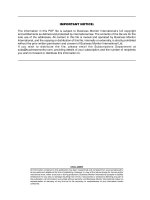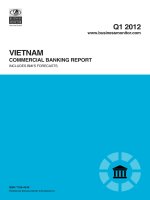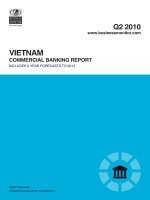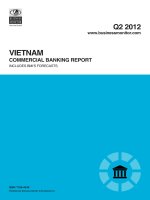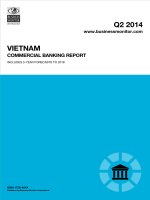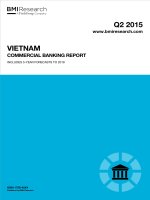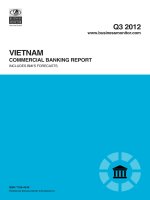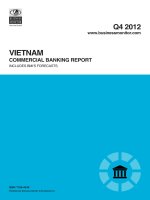Vietnam freight transport report q2 2012
Bạn đang xem bản rút gọn của tài liệu. Xem và tải ngay bản đầy đủ của tài liệu tại đây (443.59 KB, 46 trang )
Q2 2012
www.businessmonitor.com
VietnaM
freight transport Report
INCLUDES BMI'S FORECASTS
ISSN 1750-5364
Published by Business Monitor International Ltd.
VIETNAM FREIGHT
TRANSPORT REPORT
Q2 2012
INCLUDES 5-YEAR FORECASTS TO 2016
Part of BMI's Industry Report & Forecasts Series
Published by: Business Monitor International
Copy deadline: February 2012
Business Monitor International
85 Queen Victoria Street
London
EC4V 4AB
UK
Tel: +44 (0) 20 7248 0468
Fax: +44 (0) 20 7248 0467
Email:
Web:
© 2012 Business Monitor International.
All rights reserved.
All information contained in this publication is
copyrighted in the name of Business Monitor
International, and as such no part of this publication
may be reproduced, repackaged, redistributed, resold in
whole or in any part, or used in any form or by any
means graphic, electronic or mechanical, including
photocopying, recording, taping, or by information
storage or retrieval, or by any other means, without the
express written consent of the publisher.
DISCLAIMER
All information contained in this publication has been researched and compiled from sources believed to be accurate and reliable at the time of
publishing. However, in view of the natural scope for human and/or mechanical error, either at source or during production, Business Monitor
International accepts no liability whatsoever for any loss or damage resulting from errors, inaccuracies or omissions affecting any part of the
publication. All information is provided without warranty, and Business Monitor International makes no representation of warranty of any kind as
to the accuracy or completeness of any information hereto contained.
Vietnam Freight Transport Report Q2 2012
© Business Monitor International Ltd
Page 2
Vietnam Freight Transport Report Q2 2012
CONTENTS
Executive Summary ......................................................................................................................................... 5
SWOT Analysis ................................................................................................................................................. 7
Vietnam Freight Transport SWOT ......................................................................................................................................................................... 7
Vietnam Political SWOT ........................................................................................................................................................................................ 8
Vietnam Economic SWOT ...................................................................................................................................................................................... 9
Vietnam Business Environment SWOT................................................................................................................................................................. 10
Industry Trends And Developments ............................................................................................................ 11
Maritime .............................................................................................................................................................................................................. 11
Rail ...................................................................................................................................................................................................................... 12
Market Overview ............................................................................................................................................. 14
Global Oil Products Price Outlook ............................................................................................................... 16
Industry Forecast ........................................................................................................................................... 21
Road Freight ........................................................................................................................................................................................................ 21
Table: Road Freight, 2009-2016.......................................................................................................................................................................... 21
Rail Freight ......................................................................................................................................................................................................... 21
Table: Rail Freight, 2009-2016 ........................................................................................................................................................................... 21
Air Freight ........................................................................................................................................................................................................... 22
Table : Air Freight, 2009-2016 ............................................................................................................................................................................ 22
Maritime And Inland Waterways ......................................................................................................................................................................... 22
Table: Maritime Freight - Throughput, 2009-2016 ('000 tonnes and % change y-o-y) ....................................................................................... 22
Table: Inland Waterway Freight, 2009-2016 ....................................................................................................................................................... 23
Trade ................................................................................................................................................................................................................... 24
Table: Trade Overview, 2009-2016 ..................................................................................................................................................................... 24
Table: Key Trade Indicators, 2007-2016 (US$mn and % change y-o-y) ............................................................................................................. 25
Table: Vietnam's Main Import Partners, 2002-2009 (US$mn) ............................................................................................................................ 26
Table: Vietnam's Main Export Partners, 2002-2009 (US$mn) ............................................................................................................................ 26
Political Outlook ............................................................................................................................................. 27
Domestic Politics ................................................................................................................................................................................................. 27
Long-Term Politics .............................................................................................................................................................................................. 28
Macroeconomic Outlook ............................................................................................................................... 31
Table: Vietnam – Economic Activity, 2011-2016 ................................................................................................................................................. 32
Company Profiles ........................................................................................................................................... 33
Vietnam Airlines Cargo ....................................................................................................................................................................................... 33
Vinatrans ............................................................................................................................................................................................................. 35
Vietnam Petroleum Transport Company (VIPCO)............................................................................................................................................... 37
Vietnam National Shipping Lines (Vinalines) ...................................................................................................................................................... 38
Country Snapshot: Vietnam Demographic Data ......................................................................................... 40
Section 1: Population........................................................................................................................................................................................... 40
Table: Demographic Indicators, 2005-2030 ........................................................................................................................................................ 40
Table: Rural/Urban Breakdown, 2005-2030 ....................................................................................................................................................... 41
© Business Monitor International Ltd
Page 3
Vietnam Freight Transport Report Q2 2012
Section 2: Education And Healthcare .................................................................................................................................................................. 41
Table: Education, 2002-2005 .............................................................................................................................................................................. 41
Table: Vital Statistics, 2005-2030 ........................................................................................................................................................................ 41
Section 3: Labour Market And Spending Power .................................................................................................................................................. 42
Table: Employment Indicators, 1999-2004 .......................................................................................................................................................... 42
Table: Consumer Expenditure, 2000-2012 (US$) ................................................................................................................................................ 42
BMI Methodology ........................................................................................................................................... 43
How We Generate Our Industry Forecasts .......................................................................................................................................................... 43
Transport Industry ............................................................................................................................................................................................... 43
Sources ................................................................................................................................................................................................................ 44
© Business Monitor International Ltd
Page 4
Vietnam Freight Transport Report Q2 2012
Executive Summary
Vietnam's freight transport sector appears to be going from strength to strength, following the recessiondominated 2009, with growth in the medium term expected to be very healthy across the board. Leading
the way in terms of average annual growth will be the road sub-sector, which is set to average 7.14%
year-on-year (y-o-y) growth over our forecast period, to 2016. In second place will be air freight, with
6.23% growth predicted, with the port sector in third place with 6.03%. Inland waterways and rail freight
will both also enjoy healthy average increases between 2012 and 2016, of 5.73% and 5.33% respectively.
However, we caution that in order for the country to fully realise its potential, there must be an onus
placed on investment over the mid and long term, otherwise Vietnam could suffer from overcapacity.
Aside from this, the country's existing infrastructure is sadly lacking and needs a considerable financial
injection.
With the macroeconomic picture across the globe looking bleak for 2012, Vietnam's main export partners,
the US, China and Japan, are all set to suffer slowdowns during 2012, which could go on to pose some
serious headaches for Vietnam.
Headline Industry Data
2012 rail freight tonnage is set to increase by 5.29% to 8.62mn tonnes.
2012 air freight tonnage is forecast to rise by 5.72% to 206,960 tonnes.
Tonnage handled at the Port of Ho Chi Minh City in 2012 is forecast to grow 7.96% in 2012,
whereas tonnage handled at the Port of Da Nang is forecast to increase 3.08%.
2012 road freight tonnage is forecast to grow by 6.97%.
2012 total trade is forecast to rise by 8.45%
Key Industry Trends
Van Phong Port To Resume Work In 2012 At Best
Vietnam National Shipping Lines (Vinalines) signed a deal with Netherlands-based Rotterdam Port to
construct the US$3.6bn Van Phong port, it was reported in October 2011. We believe that the
international sea port project is likely to resume construction in 2012 at the earliest, given the need for
further negotiations with Rotterdam Port, Vinalines' lack of financing and the unresolved disputes with
previous developers of the projects.
© Business Monitor International Ltd
Page 5
Vietnam Freight Transport Report Q2 2012
Cat Lai Port Denies Any Involvement In Reefer Explosions
Saigon Newport, a container terminal operator at the Vietnamese Port of Cat Lai, denied any
involvement in the faulty repairs or maintenance of reefer containers which resulted in fatal explosions at
four ports in Asia and South America in November 2011. Pham Thi Thuy Van, of Saigon
Newport's marketing department, said neither the port nor the terminal operator should be blamed for the
explosions, as the maintenance and servicing of the reefers is handled either by third party vendors, or by
the shipping lines' own vendors.
New Vietnamese Container Rail Service Provides Upside Risk To Forecasts
The Vietnamese press reported at the end of 2011 that the Vietnam Railway Corporation
(VRC) was seeking to introduce a container train service connecting the Port of Hai Phong with Hanoi
and Lao Cai Province, with rail freight volumes set to increase as a result. The new service could also
reduce the number of lorries on Vietnam's roads, potentially leading to a drop in road haulage in the
South East Asian country.
Key Risks To Outlook
There should be no doubt that Vietnam's biggest obstacle will be overcapacity, and how the country plans
to traverse this will be the difference between fulfilling potential or fading into the wilderness behind
regional competitors. With demand for Vietnamese freight high, the offshoot is of course being able to
cater for this demand. If provisions are made to combat overcapacity, then this will undoubtedly provide
risks to the upside in terms of our mid and long term forecasts.
On the downside, Vietnam is certainly not immune to the stubborn global economic headwinds that
threaten to blow many an economy of course in 2012. Despite the Vietnamese government's attempts to
reduce the country's persistent budget deficit, we expect to see a cooling of the economy over the coming
quarters, with real GDP growth slipping slightly from 5.9% last year to 5.8%. With most other economies
set to suffer far worse than Vietnam in 2012, including key export partners, the freight sector may well
take a hit in 2012 as the belt tightening commences.
© Business Monitor International Ltd
Page 6
Vietnam Freight Transport Report Q2 2012
SWOT Analysis
Vietnam Freight Transport SWOT
Strengths
Weaknesses
Opportunities
Threats
Strong domestic growth rate
Stretches for thousands of kilometres on a north-south axis, creating a need for longdistance freight haulage.
Recovery of ports in 2010 is expected to continue over the medium term to 2016.
Location on the South China Sea gives the country access to the main inter-Asian
shipping routes, as well as access to the developing land transport links with ASEAN
countries, allowing the country scope to develop its trade logistics.
Generally poor state of the road network. Despite new highway construction, only
13.5% of the network is considered to be in good condition. Just 26% of the network
has two or more lanes and only 29% is tarred.
Traditionally low investment in rail, with the potential for cost-effective bulk rail freight
being underused.
Decades of under-investment have left the country with a port infrastructure system
that is poor by international standards. Overcapacity is therefore a growing problem.
Beginnings of local commercial vehicle production will help improve the stock of lorries
used by road haulage companies.
Chinese investment could bring about much needed improvements in the rail sector.
Growing international interest in Vietnam as a growth market in box shipping sector.
Risks losing out to neighbouring countries if it is unable to develop its infrastructure to
keep up with the pace of demand.
Vietnam is vulnerable to any slowdown in Chinese investment.
Drop in international demand for exports would affect Vietnam's freight transport
sector.
© Business Monitor International Ltd
Page 7
Vietnam Freight Transport Report Q2 2012
Vietnam Political SWOT
Strengths
Weaknesses
Opportunities
Threats
The Communist Party of Vietnam remains committed to market-oriented reforms and
we do not expect major shifts in policy direction over the next five years. The one-party
system is generally conducive to short-term political stability.
Relations with the US have witnessed a marked improvement, and Washington sees
Hanoi as a potential geopolitical ally in South East Asia.
Corruption among government officials poses a major threat to the legitimacy of the
Communist Party.
Increasing (albeit limited) public dissatisfaction with leadership's tight control over
political dissent.
The government recognises the threat corruption poses to its legitimacy, and has
acted to clamp down on graft among party officials.
Has allowed legislators to become more vocal in criticising government policies. This is
opening up opportunities for more checks and balances within the one-party system.
Macroeconomic instabilities in 2012 likely to weigh on public acceptance of the oneparty system, and street demonstrations to protest economic conditions could develop
into a full-on challenge of undemocractic rule.
Although strong domestic control will ensure little change to political scene in the next
few years, over the longer term the one-party-state will probably be unsustainable.
Relations with China have deteriorated over recent years due to Beijing's more
assertive stance over disputed islands in the South China Sea and domestic criticism
of a large Chinese investment into a bauxite mining project in the central highlands,
which could potentially cause wide-scale environmental damage.
© Business Monitor International Ltd
Page 8
Vietnam Freight Transport Report Q2 2012
Vietnam Economic SWOT
Strengths
Weaknesses
Opportunities
Threats
One of the fastest-growing economies in Asia in recent years, with GDP growth
averaging 7.1% annually between 2000 and 2011.
The economic boom has lifted many Vietnamese out of poverty, with the official
poverty rate in the country falling from 58% in 1993 to 9.5% in 2010.
Substantial trade, current account and fiscal deficits, leaving the economy vulnerable
to global economic uncertainties in 2012. The fiscal deficit is dominated by substantial
spending on social subsidies that could be difficult to withdraw.
The heavily-managed and weak currency reduces incentives to improve quality of
exports, and also keeps import costs high, contributing to inflationary pressures.
WTO membership has given Vietnam access to both foreign markets and capital,
while making Vietnamese enterprises stronger through increased competition.
The government will, in spite of the current macroeconomic woes, continue to move
forward with market reforms, including privatisation of state-owned enterprises, and
liberalising the banking sector.
Urbanisation will continue to be a long-term growth driver. The UN forecasts the urban
population rising from 29% of the population to more than 50% by the early 2040s.
Inflation and deficit concerns have caused some investors to re-assess their upbeat
view of Vietnam. If the government focuses too much on stimulating growth and fails to
root out inflationary pressure, it risks prolonging macroeconomic instability, which
could lead to a potential crisis.
Prolonged macroeconomic instability could prompt the authorities to put reforms on
hold as they struggle to stabilise the economy.
© Business Monitor International Ltd
Page 9
Vietnam Freight Transport Report Q2 2012
Vietnam Business Environment SWOT
Strengths
Weaknesses
Opportunities
Threats
Large, skilled and low-cost workforce, that has made the country attractive to foreign
investors.
Vietnam's location (its proximity to China and South East Asia, and its good sea links)
makes it a good base for foreign companies to export to the rest of Asia, and beyond.
Infrastructure is still weak. Roads, railways and ports are inadequate to cope with the
country's economic growth and links with the outside world.
Remains one of the world's most corrupt countries. According to Transparency
International's 2011 Corruption Perceptions Index, Vietnam ranks 112 out of 183
countries.
Increasingly attracting investment from key Asian economies, such as Japan, South
Korea and South Taiwan. This offers the possibility of the transfer of high-tech skills
and know-how.
Pressing ahead with the privatisation of state-owned enterprises and the liberalisation
of the banking sector. This should offer foreign investors new entry points.
Ongoing trade disputes with the US, and the general threat of US protectionism, which
will remain a concern.
Labour unrest remains a lingering threat. A failure by the authorities to boost skills
levels could leave Vietnam a second-rate economy for an indefinite period.
© Business Monitor International Ltd
Page 10
Vietnam Freight Transport Report Q2 2012
Industry Trends And Developments
Maritime
Van Phong Port To Resume Work In 2012 At Earliest
The troubled Van Phong port project was finally beginning to see some light at the end of the tunnel at
the end of October 2011, with project investor Vietnam National Shipping Lines (Vinalines) signing a
deal with Netherlands-based Rotterdam Port to construct the US$3.6bn international sea port. BMI
believes that the project will likely resume construction at the earliest in 2012, given the need for further
negotiations with Rotterdam Port, Vinalines' lack of financing and the unresolved disputes with previous
developers.
Construction started at the port, in the southern central province of Khanh Hoa, in October 2009.
However, works were suspended by Vinalines in June 2011 due to liquidity problems and design
disputes with the project contractor, South Korea-based SK Engineering & Construction (SK E&C),
and the project designer, Vietnam-based Portcoast.
Although the Rotterdam Port's participation could see the Van Phong project get back on track by
providing expertise and financing, we believe that there is still much scope for further delays to the
project.
Firstly, Rotterdam Port still needs to send representatives to Vietnam to conduct further negotiations with
Vinalines regarding the scope of its participation in the project. Secondly, Vinalines' liquidity disputes
with the existing developers remain unresolved. Vinalines plans to revise the design of the Van Phong
port through one of its subsidiaries, a move that will inevitably lead to a delay in the resumption of
construction works, but is still contractually obligated to pay Portcoast VND20bn for work done on the
previous design.
Lastly, current monetary conditions in Vietnam are not conducive for Vinalines to borrow domestically.
The policy rate in Vietnam rose to 15% in early October, its highest level over the past five years. This
could delay payments to previous developers and the purchase of new materials for the revised project.
The change in design for the Van Phong port is expected to void up to VND675bn of investments
previously made in the port project, inflating its overall cost. Not only is the advance paid to SK E&C
contractually forfeited, certain materials and parts purchased or manufactured for the project must be
replaced.
However, we believe Vietnam's adverse monetary conditions could lessen going into 2012, as the
softening global conditions and aggressive monetary tightening policy initiated by the Vietnamese
© Business Monitor International Ltd
Page 11
Vietnam Freight Transport Report Q2 2012
government could spur a faster decline in inflation, increasing the likelihood of domestic interest rates
being cut in early 2012. Vinalines could therefore raise the required funds in 2012 to pay all outstanding
bills for the Van Phong port project.
The Van Phong port may not be in demand over the short term, due to the current conditions in Vietnam's
port sector. South Vietnam's chief sea port, the Port of Ho Chi Minh, is facing the prospect of
overcapacity; its five newest terminals are all working well below capacity, according to Alphaliner.
Therefore, it is possible that even if the Van Phong port was completed on schedule (2015), near-term
trading volumes may not justify the cost of its construction as it may not have reached its handling target
of 0.71mn TEUs per annum.
Cat Lai Port Denies Any Involvement In Reefer Explosions
Saigon Newport, a container terminal operator at the Vietnamese Port of Cat Lai, denied any
involvement in the faulty repairs or maintenance of reefer containers which resulted in fatal explosions at
four ports in Asia and South America in November 2011. Pham Thi Thuy Van, of Saigon
Newport's marketing department, said neither the port nor the terminal operator should be blamed for the
explosions, as the maintenance and servicing of the reefers is handled either by third party vendors, or by
the shipping lines' own vendors.
Between April and October 2011, four refrigerated containers - which are predominantly used to transport
fresh food such as seafood - exploded in Brazil, China and Vietnam, with the result being that three port
workers lost their lives. More than 1,000 reefers were consequently taken out of service and stevedores at
the US ports of Oakland and Seattle refused to unload containers from Vietnam.
According to a preliminary investigation carried out by Denmark's Maersk Line, contaminated gas in the
cooling units of the containers was the likely cause of the explosions. Vietnamese officials were
scheduled to begin their own investigation on November 11 2011. Meanwhile, the port has implemented
stricter handling procedures, updating the certification of its technicians and approving its processes and
procedures with the shipping lines calling at the terminal.
Rail
New Vietnamese Container Rail Service Provides Upside Risk To Forecasts
BMI believes that rail freight volumes in Vietnam will rise following the launch of a new container train
in the country in November 2011. The new service could also reduce the number of lorries on Vietnam's
roads, potentially leading to a drop in road haulage in the southeast Asian country.
According to reports in the Vietnamese press, the Vietnam Railway Corporation (VRC) is looking to
introduce a container train service connecting the port of Hai Phong with Hanoi and Lao Cai Province.
© Business Monitor International Ltd
Page 12
Vietnam Freight Transport Report Q2 2012
The maritime facility is one of the largest in Vietnam. Located in the north of the country, it has grown
rapidly over the past decade. In 2000, Hai Phong handled 7.65mn tonnes of cargo and 218,856 twentyfoot equivalent units (TEUs). By 2010, this had risen to 15.68mn tonnes and 953,646 TEUs, growth of
104.9% and 335.7% respectively. This growth is expected to continue, with the port estimating it will
have handled 1.2mn TEUs by the end of 2011, a further growth of 25.8%.
Hai Phong is the only port in Vietnam currently connected to the national rail network. Once up and
running, the container service will provide links from the port to Lao Cai, Yen Vien, Gia Lam and Hanoi
said VRC, having completed a survey of loading capabilities. Each train to and from the port will carry 32
TEUs: 10 carriages will carry TEUs, and six will be loaded with forty-foot equivalent units (FEUs). If just
10% of the container throughput at the port was carried by rail, the traffic on National Highway 5 would
be reduced by around 200 vehicle trips.
BMI notes that VRC's proposal provides upside risk to our rail freight forecasts. Volumes carried on
Vietnam's rail network saw four consecutive years of decline from 2007 to 2010, falling from 9.05mn
tonnes to 7.81mn tonnes. In 2011, we forecast that volumes will return to growth, rising 4.8% to 8.19mn
tonnes. From 2012 to 2016 we project annual growth to average 5.3% per annum, rising to 10.62mn
tonnes at the end of our forecast period, exceeding levels achieved prior to the slump. The new container
service could see these growth rates exceeded.
Equally, the upside risk to our rail freight forecasts is matched by downside risk to our road freight
volumes in Vietnam. Over the same 2012-2016 forecast period, BMI anticipates growth in road haulage
to average 5.6% per annum. If the container service takes off, however, and more volumes are moved off
the roads and onto rail (which is both greener and reduces congestion on roads), our outlook could be
affected.
© Business Monitor International Ltd
Page 13
Vietnam Freight Transport Report Q2 2012
Market Overview
Vietnam's real GDP growth figure came in at 6.1% year-on-year (y-o-y) in Q311, in line with our view
that monetary tightening by the State Bank of Vietnam (SBV) and a reduction in public spending would
continue to be a drag on growth over the coming quarters. Meanwhile, downside risks to our outlook on
external demand - a sputtering economic recovery in the US, sovereign debt concerns in the eurozone and
a potential hard landing in China - have escalated significantly in recent months. Consequently, we have
downgraded our real GDP growth forecast from 6.3% to 6.0% for 2011 to reflect a deteriorating
economic environment that we expect to persist over the coming months. Looking into 2012, we believe
Vietnam's real GDP growth will remain subdued by historical standards at 6.5% as weak economic
momentum spills over into H112.
Domestically, we expect to see welfare subsidies rise as cooling external demand translates into higher
unemployment for the manufacturing sector. Furthermore, we expect tax revenue growth to slow
significantly as a result of cooling private sector income growth.
Retail sales have moderated considerably since November 2010, when the SBV initiated its monetary
tightening cycle. Retail sales growth slowed from 32.5% in November 2010 to 22.6% in June 2011,
indicating that the measures have dampened private consumption growth. Nonetheless, retail sales remain
at double-digit growth rates, indicating that private consumption growth remains resilient. This supports
our view that private consumption would remain resilient on the back of robust labour market conditions
and rising wages in Vietnam, boding well for containerised imports. However, public spending cuts and a
subdued outlook on gross fixed capital formation (GFCF) growth due to high lending rates would lead to
continued moderation in domestic demand.
Road Freight Remains The Dominant Force
Road transport is the most advanced in terms of freight sector privatisation and is by far the dominant
mode for freight in Vietnam, with a market share of around 75% of domestic cargo. Few foreign
companies are present in the market, and there are many small, family owned road freight companies
operating informally.
Vietnam has a national road network of 171,392km. BMI believes the sector requires substantial
investment. The quality of Vietnam's road infrastructure was judged by the World Economic Forum
(WEF) to be very poor, ranking 123rd out of 142 countries surveyed in its Global Competitiveness Report
2011-2012.
Vietnam's railway transport sector has just one operator, the Vietnam Railway Corporation (VRC),
established in April 2003 as a state corporation operating railway transport and related services.
© Business Monitor International Ltd
Page 14
Vietnam Freight Transport Report Q2 2012
Vietnam's rail network totals 2,347km. The network is of mixed-gauge, comprising 2,169km of 1.000m
gauge and 178km of 1.435m gauge. Railway infrastructure in Vietnam was ranked 101 out of 123 by the
WEF.
Vietnam's dense river and canal network provides the country with a highly developed inland waterway
system of 17,702km. This is the second largest sub-sector involved in domestic cargo transport,
accounting for 25-30% of total transport volumes.
Vietnam's seaport network comprises of many small and medium-sized entities, with inefficient
distribution. Most large ports are located on rivers, like Hai Phong and Ho Chi Minh City, with limited
depth at the entrance. Some ports are located in big cities, thus making it difficult to connect with other
modes of transport for cargo transfer due to traffic congestion.
Vietnam's port infrastructure is poor by international standards. The WEF's 2011 Global Competitiveness
Report ranks it 111th out of 142 countries, placing it 12th in the region, just one place ahead of the
Philippines, the regional underperformer.
Investment And Development Outlook
According to our key infrastructure projects database, there are US$171bn worth of infrastructure projects
planned, or currently under way, in Vietnam's transport sector. One of the most expensive of these is a
US$3.6bn plan to build the Van Phong International Entrepot. The project will begin with the
construction of two deep water ports in Dam Mon that will be able to accommodate container ships with
tonnage of 9,000 twenty-foot equivalent units (TEUs) and the capacity to handle 0.5mn TEUs per year.
The project is currently suspended, however, due to an ongoing review of geological conditions at the
site.
The air freight sector will undoubtedly benefit from the planned construction work on a new passenger
terminal at Long Thanh international airport. Costing an estimated US$6.7bn, the work would also
incorporate a new runway, providing capacity for 100mn passengers a year. A tender for investment
consultancy work was under development as of December 2011.
© Business Monitor International Ltd
Page 15
Vietnam Freight Transport Report Q2 2012
Global Oil Products Price Outlook
Lower Fuels Prices To Help Weather Global Headwinds
BMI View: BMI’s latest refined fuels forecast indicates there will be a fall in prices between 2012 and
2016, with the sharpest falls taking place over 2012 and 2014. On one hand, cheaper fuels will certainly
help many struggling industries (such as aviation, land freight and petrochemicals) in the coming years,
with North American consumers set to profit less from this expected decline relative to other regions. On
the other, lower demand and falling prices imply that many refiners will continue to struggle, particularly
in Europe and the US north east. However, we still see room for growth for refiners in some emerging
countries and in some parts of the US.
Fall In Prices Across The Board
Oil Products Price Forecasts, 2012-2016 (US$/bbl)
f = forecast; bbl = barrel. Source: BMI
When we last published our global oil products outlook, in October 2011, oil prices were on a downward
trend because of a recovery in output. Libyan oil was fast coming back onstream, reaching nearly 1mn
barrels a day (b/d), according to our latest estimates, and other disruptions around the world were
receding, though some of them were expected to spill over into 2012.
© Business Monitor International Ltd
Page 16
Vietnam Freight Transport Report Q2 2012
Although we expected a supply deficit in 2012, particularly in the first half of the year, rising production,
particularly from unconventional projects in the Americas, was expected to ease the tension between
supply and demand. The ongoing European debt crisis and slower than expected growth in the US had
dampened our consumption outlook.
However, recent developments in the market have highlighted some significant upside risks. Volatility is
likely to remain high, as suggested by continued Iranian and US sabre rattling in the Strait of Hormuz,
which could have resulted in a US$5-US$15 per barrel (bbl) premium at current prices. Furthermore,
unless demand contracts in an unprecedented fashion, a clear price floor has been established due to the
cost of developing the capital-intensive projects from which much of 2012’s stabilising volumes are
expected to be drawn.
First Steps To Recovery For Refiners
With regard to downstream operators, BMI sees three main geographic blocks emerging: North America,
emerging markets and Europe.
In the US, although higher feedstock prices have caused many refineries to close in the north east, cheap
domestic crudes in the Midwest, the Rockies and on the Gulf Coast have generated very high margins.
Furthermore, rising gasoline margins, compounded by growing diesel export volumes to booming Latin
American markets, offer substantial opportunities for growth, particularly in the Gulf Coast region.
In emerging markets, high crude prices have forced many governments to revise their fuel subsidies.
Although we still expect many refiners to incur losses in 2012, as they will still be expected to perform
their ‘national duty’ by providing cheap energy to fuel growth, their prospects are clearly improving.
India, Iran, Nigeria, Indonesia and China, among others, have all liberalised prices or are expected to.
This offers growth opportunities not only for domestic operators but also, in some cases, for foreign
operators.
In Europe the outlook is bleaker, with many plants shutting. Neighbouring emerging markets, rather than
offering prospects for export, are a source of competition, as Russia, the Middle East and North Africa
enjoy cheap feedstock and are constantly increasing capacity and standards. Consequently, operators
willing to approach the European market would be better advised to invest in neighbouring oil-rich
countries, particularly in the Middle East, as these countries also have access to booming Asian markets.
Diesel Prices To Offer Relief To Land Freight
Diesel prices are largely expected to follow a downward trend over 2012-2016, with most of this
correction taking place in 2012-2014. We see global prices, an average of the Singapore and Rotterdam
benchmarks, falling by nearly 6.20% in this period, as opposed to 0.91% in 2014-2016. For many land
freight companies this will be a source of relief as current global headwinds are likely to hurt most
© Business Monitor International Ltd
Page 17
Vietnam Freight Transport Report Q2 2012
operators, particularly those in developed markets. This also implies that beyond 2014 growth will have
to come from rising revenue rather than fuel savings. If freight volumes fail to pick up, cost savings will
have to be made in other departments.
In terms of geography, prices are expected to fall by approximately 1.80% for both the Singapore and
Rotterdam benchmarks over the forecast period. This is likely to give a disproportionate advantage to
emerging Asian and African road freight operators, where the economic headwinds are unlikely to
destroy demand as significantly as they will in Europe.
Diesel Prices Die Down
Gasoil/Diesel Prices, 2006-2016 (US$/bbl)
f = BMI forecast. Source: BMI, Bloomberg
A Gentler Fall In Gasoline Prices
Gasoline prices will follow the same downward trend as diesel and most of the correction in prices
(-4.68%) will take place in 2012-2014, with only a minor 0.74% fall in 2014-2016. However, as the
overall fall in prices will be smaller than the fall in diesel prices, gasoline markets, such as the US, will
enjoy smaller returns from any correction, a trend that will be exacerbated by geographical discrepancies
between gasoline benchmarks. BMI sees the US gasoline benchmark falling by just 0.51% in 2012-2016,
compared to 1.75% and 1.78% in Europe and Asia respectively.
Cheaper Kerosene To Benefit Latin America And Middle East
Kerosene will offer some relief to the troubled air freight market. With weak consumer sentiment
dampening demand for air freight because of the economic woes in Europe and North America, Asian
exports are also set to take a hit. However, falling kerosene prices should offer some relief to margins,
© Business Monitor International Ltd
Page 18
Vietnam Freight Transport Report Q2 2012
particularly in Europe and Asia. Outperforming air freight markets, such as the Middle East and Latin
America, will both experience higher demand and lower costs, thereby boosting margins.
US Unleaded Gasoline Leads The Way
Gasoline Prices, 2006-2016 (US$/bbl)
f = BMI forecast. Source: BMI, Bloomberg
Jet Fuel Price Landing
Jet/Kerosene Prices, 2006-2016 (US$/bbl)
f = BMI forecast. Source: BMI, Bloomberg
© Business Monitor International Ltd
Page 19
Vietnam Freight Transport Report Q2 2012
Naphtha To Boost Middle East Petrochemicals
Falling naphtha prices will do little to save the ailing Western petrochemicals markets. The European and
North American petrochemicals industries have mostly followed the lead of the refining industry. Much
like the downstream segment, an ailing European petrochemicals industry implies that Middle Eastern
operators could strengthen their presence on the continent. Middle Eastern operators will not only benefit
from better market conditions, they will also enjoy lower feedstock costs as the fall in naphtha prices will
be sharpest in Asia (where refined fuels prices are indexed to the Dubai Fateh).
Mix ‘n’ Match
Naphtha Prices, 2006-2016 (US$/bbl)
f = BMI forecast. Source: BMI, Bloomberg
While there will be a sharp fall in refined fuels prices in 2012, cheaper costs are only likely to help most
companies weather the crisis rather than avoid it. As for refiners, lower demand and lower prices will
continue to hurt margins, though we see room for growth in some emerging countries and in some parts
of the US.
© Business Monitor International Ltd
Page 20
Vietnam Freight Transport Report Q2 2012
Industry Forecast
Road Freight
Road Freight Continues To Dominate
Our forecasts for Vietnam's road freight sector suggest further strong growth over the medium term. For
2012 we expect y-o-y growth of 6.97%, up from an estimated 6.47% in 2011. In terms of medium-term
annual growth, BMI sees an average of 7.14% to reach 846.83mn tonnes.
Table: Road Freight, 2009-2016
2009
'000 tonnes
2010
2011e
2012f
2013f
2014f
2015f
2016f
494,649.80 563,406.12 599,863.21 641,689.03 688,531.87 738,564.31 789,140.46 846,827.50
- % change
y-o-y
mn
tonnes/km
8.50
13.90
6.47
6.97
7.30
7.27
6.85
7.31
30,261.40
34,467.73
36,840.47
39,562.62
42,611.29
45,867.56
49,182.10
52,897.32
8.20
13.90
6.88
7.39
7.71
7.64
7.23
7.55
- % change
y-o-y
e/f = BMI estimate/forecast. Source: General Statistics Office of Vietnam
Rail Freight
Table: Rail Freight, 2009-2016
'000 tonnes
- % change y-o-y
mn tonnes/km
- % change y-o-y
2009
2010
2011e
2012f
2013f
2014f
2015f
2016f
8,068.10
7,809.92
8,187.28
8,620.20
9,105.06
-4.87
-3.20
4.83
5.29
5.62
5.69
5.99
4.05
3,805.10
3,717.58
3,893.05
4,094.36
4,319.82
4,560.63
4,799.43
5,120.22
-8.77
-2.30
4.72
5.17
5.51
5.57
5.24
6.68
9,622.93 10,199.06 10,612.12
e/f = BMI estimate/forecast. Source: General Statistics Office of Vietnam
© Business Monitor International Ltd
Page 21
Vietnam Freight Transport Report Q2 2012
Rail Recovers
The rail freight sector will safely put the twin contractions of 2009 and 2010 out of sight with 2012 and
beyond set to reflect 2011's steady growth pattern. For 2012 we expect growth of 5.29%, with the average
annual growth over the forecast period just beating this figure, at 5.33%, to reach 10.61mn tonnes in
2016, up from 2012's forecast 8.62mn tonnes.
Air Freight
Growth Steady, But Work To Be Done
In common with the sectors mentioned above, Vietnam's air freight sector will enjoy steady growth rates
over the medium term. We see an annual average of 6.23% over our forecast period, with tonnage
throughput increasing from 206,960 tonnes in 2012 to 264,780 tonnes by the end of 2016. In 2012 BMI
forecasts y-o-y growth of 5.72%, up slightly on 2011's 5.25%. However, the Vietnamese air freight sector
is by far the country's smallest in terms of annual tonnage throughput.
Table : Air Freight, 2009-2016
'000 tonnes
- % change y-o-y
mn tonnes/km
- % change y-o-y
2009
2010
2011e
2012f
2013f
2014f
2015f
2016f
139.60
186.00
195.76
206.96
219.51
232.90
248.23
264.78
6.24
33.24
5.25
5.72
6.06
6.10
6.58
6.67
316.60
492.20
516.23
543.79
574.66
607.63
643.02
686.43
7.10
55.46
4.88
5.34
5.68
5.74
5.82
6.75
2013f
2014f
2015f
2016f
e/f = BMI estimate/forecast. Source: General Statistics Office of Vietnam
Maritime And Inland Waterways
Table: Maritime Freight - Throughput, 2009-2016 ('000 tonnes and % change y-o-y)
2009
Port of Ho Chi Minh City
- % change
Port of Da Nang
- % change
2010
2011e
2012f
19,140.00 31,132.00 33,450.71 36,111.78 39,148.54 42,406.25 45,902.18 49,652.56
-5.15
62.65
7.45
7.96
8.41
8.32
8.24
8.17
3,132.00
3,303.04
3,394.27
3,498.97
3,618.45
3,746.62
3,915.76
4,097.21
14.21
5.46
2.76
3.08
3.41
3.54
4.51
4.63
e/f = BMI estimate/forecast. Source: Port authorities
© Business Monitor International Ltd
Page 22
Vietnam Freight Transport Report Q2 2012
Ho Chi Minh Port's growth forecast for 2012 is set to reflect the slower GDP growth in Vietnam. We are
sticking with last quarter's prediction that the port's container throughput will increase by 4.8% in 2012 to
3.1mn twenty-foot equivalent units (TEUs), a slowdown from the double-digit growth in the years prior
to 2011. We also stick to Q112's tonnage throughput growth forecast of 8%, to reach 36.11mn tonnes.
However, growth at the Port of Da Nang will not mirror that of Ho Chi Minh City, with 2012's forecast
set to be 3.08%, albeit an increase on 2011's estimate. Over the medium term, the port is set to see
average annual tonnage throughput of 3.83%, compared to the Port of Ho Chi Minh's 8.22%.
Inland waterways will also enjoy the healthy growth we expect to see in other sectors over the medium
term. In 2012 we forecast growth of 5.11%, a figure that will be surpassed by the predicted y-o-y average
over the forecast period of 5.73%.
Table: Inland Waterway Freight, 2009-2016
2009
'000 tonnes
- % change y-o-y
mn tonnes/km
- % change y-o-y
2010
2011e
2012f
2013f
2014f
2015f
2016f
135,688.40 142,201.44 148,378.09 155,960.44 164,659.38 174,401.76 184,807.51 196,014.15
2.00
4.80
4.34
5.11
5.58
5.92
5.97
6.06
25,365.20
25,593.49
26,752.09
28,084.60
29,568.40
31,159.70
32,622.02
34,541.55
2.00
0.90
4.53
4.98
5.28
5.38
4.69
5.88
e/f = BMI estimate/forecast. Source: General Statistics Office of Vietnam
© Business Monitor International Ltd
Page 23
Vietnam Freight Transport Report Q2 2012
Trade
Table: Trade Overview, 2009-2016
Real growth, %
y-o-y
2009
2010
2011e
2012f
2013f
2014f
2015f
2016f
Imports
-13.81
22.40
15.32
8.00
6.80
6.50
6.50
6.50
Exports
-15.00
24.81
15.00
8.90
8.00
8.00
8.00
8.00
Total trade
-14.40
23.61
15.16
8.45
7.40
7.25
7.25
7.25
73.27
90.90
145.79
166.69
194.10
229.61
260.83
293.22
- % change y-o-y
-12.87
24.06
60.37
14.34
16.44
18.30
13.60
12.42
Exports, US$bn
63.63
80.27
120.57
139.01
163.68
196.36
226.20
257.87
- % change y-o-y
-9.57
26.14
50.22
15.29
17.75
19.96
15.20
14.00
Total trade, US$bn
136.91
171.17
266.36
305.70
357.78
425.97
487.02
551.08
- % change y-o-y
-11.37
25.03
55.61
14.77
17.04
19.06
14.33
13.15
Nominal
Imports, US$bn
e/f = BMI estimate/forecast. Source: General Statistics Office of Vietnam, BMI
© Business Monitor International Ltd
Page 24
